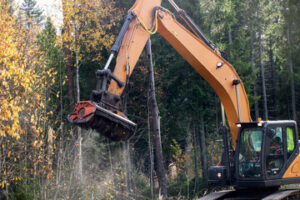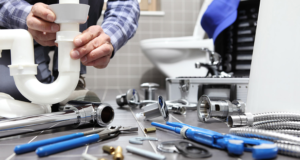Forestry Mulching Services Near Me is an efficient, eco-friendly way to clear land. This process converts overgrown vegetation into nutrient-rich mulch and prevents soil erosion. It also improves soil health, combats invasive species and promotes native plant growth.

Unlike traditional clearing methods, which require multiple pieces of equipment and can cost more, forestry mulching involves a single machine that processes brush and debris on the spot. It also eliminates the need for hauling and burning debris.
Forestry mulching is a safe and environmentally friendly alternative to traditional land clearing methods. It uses a specialized machine to grind up vegetation and organic matter, resulting in a layer of nutrient-rich mulch that helps retain moisture, prevent soil erosion, and improve soil health. In addition, it helps reduce weed growth and encourages native species to thrive. The mulch also helps protect against wildfires and supports wildlife habitats.
Forest mulching is also highly efficient compared to traditional land clearing methods, as it eliminates the need for cutting, hauling, and disposing of vegetation. This streamlined process saves time and money for the landowner, while also decreasing carbon emissions.
This method of land clearing is ideal for agricultural expansion, reducing fire risks, and creating recreational trails. It also enhances the productivity of pastureland by eliminating invasive plants and promoting the growth of desirable grasses. Furthermore, it is an effective way to manage timberland and prepare the area for construction or farming.
The Smith family hired a forestry mulching service to clear the overgrown brush on their ranch and restore the pastureland’s natural grazing areas. This helped the cattle graze more efficiently, and it restored the soil’s fertility. The forestry mulching process also reduced the need for chemical herbicides and increased biodiversity.
While land clearing can be performed manually or with a bulldozer, it can be challenging and dangerous for the untrained worker. To avoid these risks, it is best to work with an experienced forestry mulching company that has the equipment and expertise needed to complete the job quickly and safely.
Forestry mulching services utilize a specialised machine that uses a rotating drum adorned with steel teeth or blades to shred vegetation into small pieces. The machine is then pushed forward, crushing the shreds into a loose pile. This process reduces the need for manual labor and enables you to clear large tracts of land in less time.
This method of land clearing is safer than conventional bulldozing because it reduces the need for burning and debris removal. It also eliminates the need to transport waste, which reduces greenhouse gas emissions and pollution. Additionally, forestry mulching does not require the use of chemicals or fuels, and it does not produce smoke or harmful gases during operation.
Eco-friendly
Forestry mulching is an eco-friendly alternative to traditional land clearing methods, such as bulldozing. Using a forestry mulching machine, trees and other vegetation are ground up on-site to create a layer of natural mulch, which prevents soil erosion. It also helps to improve soil health, promotes biodiversity, and reduces the need for fertilizers. In addition, it mitigates the effects of Florida rain by protecting the soil from water runoff.
Unlike land clearing, which destroys animal habitats and causes soil erosion, forestry mulching does not disrupt ecosystems or tamper with the landscape. Instead, it allows you to use your land for agricultural purposes or building homes and roads. Moreover, forestry mulching does not use heavy machinery or require large amounts of labor. This makes it an ideal solution for environmentally sensitive areas.
Another advantage of forestry mulching is that it is fire-safe and preserves biodiversity. This is because a layer of organic material in the soil can reduce the risk of fire by reducing fuel load and encouraging native plants to grow. Moreover, it can help to protect fences and power lines.
In addition to its environmental benefits, forestry mulching is also an effective way to manage invasive species. The specialized machines used in this process are capable of grinding up trees and brush into a mulch that is safe for the environment. Moreover, these machines are much more efficient than manual tools or chemical pesticides.
Moreover, forestry mulching can be used to perform a wide range of tasks, including preparing sites for projects and managing undergrowth without the need for traditional land clearing techniques. It is also useful for preventing the spread of invasive plants and creating hiking trails. In addition, it can improve a property’s aesthetics by transforming overgrown landscapes into something more beautiful.
Cost-effective
Forestry mulching is an efficient and eco-friendly alternative to traditional land clearing methods. It utilizes specialized equipment to grind vegetation into mulch on-site, reducing labour and fuel costs. It also allows for faster land preparation and fewer disturbances to the surrounding soil. Unlike bulldozing, which can cause soil compaction and erosion, the process leaves the ground undisturbed and promotes a healthy soil ecosystem.
This approach is cost-effective for a variety of purposes. For example, it can be used to clear invasive species, create fire breaks, and manage forest health. Moreover, it can be beneficial for property owners, as it reduces the risk of wildfire and helps protect fence lines and power lines. It also helps preserve soil nutrients and prevents the need for chemical fertilizers.
Unlike conventional land clearing methods, forestry mulching produces zero waste. In contrast, traditional land clearing involves cutting, burning, and hauling away debris. This can result in significant expenses for the property owner, and often requires a substantial investment of time and money. Furthermore, clearing and grubbing can also leave soil exposed to wind and rain, leading to erosion and reducing the natural resilience of the land.
The forestry mulching process also eliminates the need for disposal and reduces the risk of soil erosion, protecting waterways and preventing sedimentation. Furthermore, the shredded vegetative matter provides a rich source of organic material for nutrient cycling. This enhances the soil structure, improves aggregation and porosity, and supports plant hydration and drought resistance. It also contributes to carbon sequestration and ecosystem biodiversity.
In addition to its environmental benefits, forestry mulching can also save landowners money by eliminating the need for costly landfill space. It is also more economical than using chemicals and fuel for the removal of invasive plants. Moreover, the mulch layer created by this process is effective in stifling invasive weeds and promoting native growth.
Invasive weeds can interfere with agricultural production, outcompeting the original crop or inhibiting natural habitats. Consequently, many farmers are turning to forestry mulching as an effective way to restore their land. For instance, a cattle ranch in West Virginia employed this method to remove invasive brush and trees from their pastures. This not only improved grazing conditions for their livestock, but also rejuvenated the soil and promoted the growth of healthy grasses.
Safe
Forestry mulching is an environmentally-friendly land clearing method that uses a special machine to grind up overgrown vegetation. The result is a layer of nutrient-rich mulch that protects soil from erosion and promotes the growth of native plants. It also helps prevent the spread of unwanted invasive tree species.
Forest mulching is a cost-effective alternative to more traditional land clearing methods, such as burning and bulldozing. It can be used for a variety of purposes, including preparing land for agricultural use, reducing fire risk in wooded areas, and creating hiking trails. Additionally, forestry mulching can be used to clear and maintain roads and fence lines.
The process of forestry mulching involves using a specialized machine to grind up overgrown trees, shrubs, and brush into a fine mulch and grass clippings. The mulch is then spread onsite as a protective covering for the soil. This allows for the natural fertilization of the soil and reduces the need for artificial fertilisers. In addition, the mulching process preserves root systems and minimizes soil erosion.
Another benefit of forestry mulching is that it provides wildlife habitat structures, which encourage biodiversity and ecological balance. In contrast to the destruction caused by clear-cutting and burning, forestry mulching creates downed logs and brush piles that provide food, shelter, and nesting sites for wildlife. It also helps in the preservation of water quality by preventing the washout of nutrients and sediments from the soil.
In addition, forestry mulching helps to combat weed growth by blocking sunlight and limiting nutrient competition. This can help to reduce the need for chemical herbicides, which are harmful to the environment. It also aids in reducing the risk of wildfires by removing debris and fuel sources, which can contribute to forest fires.
For commercial and residential landowners, forestry mulching is an effective solution for maintaining infrastructure. It can be used to clear trees, brush, and invasive plants around power lines, pipelines, and other utility facilities. It can also be used to maintain fence lines and property boundaries. For agricultural purposes, forestry mulching is an efficient way to prepare land for growing crops or pastures and to manage grazing livestock.


